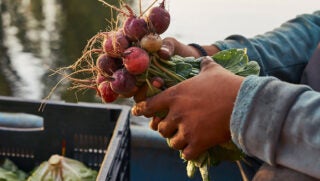The 2022 Agriculture Census aims to collect a complete count of United States farmers, ranchers, and those who operate agriculture productions.
Taken once every five years, the census provides data to the producers of goods and services, political representatives, and consumers who vote, information on how to make an informed decision about the agriculture industry in each of their respects. The data is collected throughout the 2022 year, and results are available online at the U.S. Department of Agriculture’s Census of Agriculture website in 2024.
For the last fifteen years, the census has recorded a positive upward trend of Black agriculturalists entering the industry, predominately in most southern states. Recorded every year ending in “2” and “7,” the 2007 census charted a 5 percent upward trend in Black farmers, 2012 a 12 percent hike, and back to a 5 percent upward trend in 2017.
Historically, access to funding and resources for Black, Indigenous, and people of color (BIPOC) agriculturalists has hindered their entrance into the agricultural sector. Also, the longtime lack of recognition of systemic discrimination in USDA policy, practices, and other government entities has created historical barriers for BIPOC agriculturalists to navigate the industry. The 2021 American Rescue Plan and USDA Equity Commission’s activism for Black and brown producers supports a positive trend in Black agriculturalists for this next census (See articles on the 2021 American Rescue Plan and USDA Equity Commission’s advocacy).

The promise of interim ideas for enhanced equitability for Black and brown agriculturalists 12 months after the USDA Equity Commission’s inception in October with an additional 2 years for the final report shows a brighter trajectory for Black farmers.
This is exciting news for the possibility of new agriculturalists after the commission’s ideas are set in motion. However, there is still another issue of access to land that could hinder Black farmers who aim to enter the industry in the near future.
Over the last three Agriculture Censuses, it has been recorded that Black farmers have increased but the land owned and operated has decreased.
As recorded in the 2017 Agriculture Census, Black farmers own 4.7 million acres across the United States and incur $1.4 billion in revenue. The highest amount of land owned by Black farmers, on average, is 10 to 49 acres. However, Black farmers have lost 3 percent of the demographic’s collective land ownership data every five years. This decrease is due in part to what many farmers struggle with: increased cost of operation not being met by how much the operation grosses in sales of commodities or goods. For many Black and brown agriculturalists, much of their land is uprooted from them due to a systemic lack of legal land titles.
According to a congressional briefing on racial equity in U.S. farming, some farmers lack a clear title to or documented legal ownership of the land they farm. Research also suggests that this issue may have contributed to land loss among farmers of color, in particular, Black farmers and Native American farmers.
Lack of legal land titles has led to succession and land sale issues around the country for Black and brown agriculturalists.
Even though all the action for Black and brown agriculturalists on Capitol Hill predicts the number of Black farmers to increase, there are still actions right at home that can guarantee our voices being heard and represented in data, subsequently finding themselves in the decision making rooms that use this data to inform their actions on what happens to us Black agriculturalists and their resources. With that said, we need to be representing ourselves by applying and filling out the 2022 Census of Agriculture questionnaire.
So, what should all operators know about filling out the 2022 Census of Agriculture?
1. Apply if you gross $1,000 or more a year:
Even small plots of land, regardless of size, rural or urban, can apply to fill out the Agriculture Census. As long as the operation deals in agriculture production, whether it be in the category of growing fruit, vegetables, or some food animals. As long as the operation raises and sells $1,000 or more of such products listed, they may apply. This also includes operations that would have normally been raised or sold, including operations who may have had financial struggles during and as a result of COVID-19. As long as those operations apply during the census year, they can be a part of the data.
2. Important Dates to consider:
Each agricultural operator should have signed-up for the census by June 30, 2022. During June 2022, census forms are mailed out and responses are due February 2022. Data will be released to the public online during the spring/summer of 2024.
3. What the 2022 Agriculture Census provides over the next five years:
Representation matters. If every operator applied and filled out the census, they too can be represented in data that reflects their operation’s status. This information can inform resource providers on how to provide services to help grow new and existing operations. The data presented in the census can also provide policy makers and constituents with information on how they could vote to improve operations’ growth.
Check out more information on the 2022 Census of Agriculture today so you can view the information asked of each operation and provide that accordingly. Be represented. Share your voice. Offer information so we can collect data that reflects the real face of all populations working and growing the agricultural industry.
Especially for those populations the most underrepresented, as we work to involve and sustain all walks of life within our industry and the generations that come after them.
Bre Holbert is a past National FFA President and studied agriculture science and education at California State-Chico. “Two ears to listen is better than one mouth to speak. Two ears allow us to affirm more people, rather than letting our mouth loose to damage people’s story by speaking on behalf of others.”



